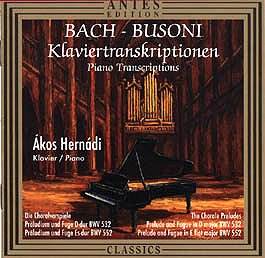Legend has it that an American lady of high society,
on being introduced to Busoni at a party, exclaimed in innocent rapture,
"Say, you can't mean Mr. BACH-Busoni!". Maybe nowadays
Bach-Busoni is not served up so regularly and, whether Busoni's own
music is actually played any more than it was then, ladies of high society,
on whatever side of the Atlantic, if they know the name at all will
most likely know he was a composer.
Still, it's Mr. Bach-Busoni we have here and, at least
in places, marvellous to hear him again. Hernádi asks us to hear
these as romantic pieces and hopes that the "reader" (what
about the listener?) will "enjoy the works presented here both
as Bach-Busoni and as an incomparable collection of imaginative piano
sonorities". His flak-shooting essay (well, better stimulating
thoughts by the performer than a dutiful essay by a hack who couldn't
care less, I suppose) warns us that "the ten chorale-preludes …
will surely inspire no Urtext-possessed flagellants to take out their
whips. The era of dogmatism seems to have come to an end with the close
of the last century". Cowering in my trench with my Urtext as my
only protection, I have to say that some procedures seem to me a little
odd. When a piece is for the most part a straight transcription such
as any of us could do, as in the second Durch Adams Fall prelude
(it's not a fugue, as the booklet says), why does Busoni suddenly rewrite
a few bars completely and then go back to the straight and narrow? It
would appear that most of the preludes from the Orgelbüchlein
are too short for him so he sets about making them longer. At its most
innocent this just means repeating sections that Bach didn't intend
to have repeated, but it can also mean the wholesale addition of new
sections of his own composition (remarkably well done, it must be said)
or, at the very least, the odd cadenza and a few extra chords at the
end. At the other extreme, why make a big cut towards the end of the
E flat "St. Anne" Prelude? And is it really so imaginative
to have so many thunderous bass octaves, imitating a 16-foot stop that
wasn't available to Bach?
Urtext-possessed flagellation apart, there are some
outstanding successes on this record, together with some failures. When
I put it on and heard the start of the D major Prelude I thought what
an over-pedalled mess. Since there are no bass-notes to be held down
under the faster notes I don't understand why Hernádi thought
this necessary. I know some cathedral acoustics make a worse mess still,
but if the idea is not to imitate the organ but to create new piano
music, then surely it should sound like good piano music. Also in the
St. Anne Prelude, the downward scale-figure which pervades the dotted-rhythm
sections is systematically blurred with pedal. However, in the D major
fugue Hernádi readily communicates his excitement at the music
and builds it up very well indeed. So this is one success and another
is very definitely Nun freut euch where the separation between
running semiquavers, striding quavers and the chorale melody is superb,
and the semiquavers express that sheer joy in moving the fingers brilliantly
that is the essence of a certain part of Bach's work. Another success
in a wholly different vein is Wachet auf, where the chorale melody
and the theme which appears on the strings in the Cantata - one of Bach's
greatest melodies - both sing out nobly over a rich bass. This is a
welcome counter to the chopped-up phrasing we often get in the name
of authenticity today. Ich ruf' zu dir is made into a beautifully
romantic nocturne, though Hernádi's tone, attractive in piano,
gets a little hard as the volume rises. And what a splendid peal of
bells he and Busoni make of In dir ist Freude.
A piece that doesn't work is the first of the Durch
Adams Fall preludes. When a chorale melody and a legato bass-line
enclose semiquaver figuration in the inner parts, the only way to hold
the long notes is to pedal through the semiquavers. This is all right
when they are fairly diatonic, but when they are as chromatic as here
the result is a dissonant muddle. As far as I can see the miscalculation
is Busoni's rather then Hernádi's.
I could go on but I think I have made it clear that
there is much more to be enjoyed than not. There is something rather
heartwarming about Hernádi's patent enjoyment of everything he
does and I'd like to hear him in some real Bach - provided he keeps
a close watch on his pedalling.
Christopher Howell
Hernadi
web site
